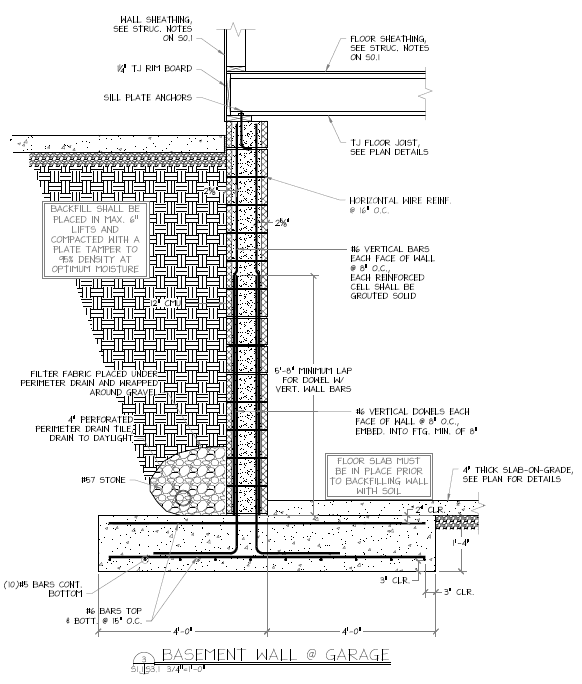StrucDesignPE
Structural
I am working on the design of a custom house, nothing fancy, but the client's layout has an attached garage at the rear basement wall.
My design approach:
1) Designed the wall as a cantilevered retaining wall so that the client can have the basement backfilled with controlled, compacted fill prior to placing the floor framing to provide restraint to the top of the wall.
2) I then design for the restrained condition wherein the reinforcing is on the opposite face as the cantilevered condition.
3) My surcharge load on the retained soils is 150. I assumed 75 psf for a 6ish inch thick slab and then another 75 psf just in case heavier vehicles are parked in the garage. This is greater than the 40 or 50psf that I have seen in building code.
4) I don't know much at this point about the soils on site, so I designed for 45 active and 60 at-rest. My client said they are okay with designing it conservatively.
5) The total wall height is 9'-4". There may be a larger step in the location of garage slab in relation to the floor framing. I am waiting to hear back from the client for the definitive answer.
My concerns:
1) I am always concerned about compacting soils next to the foundation wall, especially with CMU. However, my client wants to keep the CMU. What concerns do any of you have with compacting in small lifts with a small plate tamper against basement walls. Mind you, this will be done when the wall is in the cantilevered configuration and not restrained at the top of the wall.
2) I am also concerned about potential for the garage slab to settle and crack if there happens to be settlement in the compacted soil. I don't anticipate that, but I think it is possible given the right conditions.
3) I don't want to detail the slab to sit on the foundation wall and be reinforced to bridge over the excavated and loosely backfilled soil wedge. I personally think that is a messy detail and depending on the skill level of the contractors, may not be done correctly or may be overly costly.
Pasted below, you will find my detail for this condition as I have designed it so far. I am asking all of this because I have not personally designed a condition like this to date and like the idea of second opinions. I know this is commonly done here in my region of the US, but I have not personally dealt with one such as this.

My design approach:
1) Designed the wall as a cantilevered retaining wall so that the client can have the basement backfilled with controlled, compacted fill prior to placing the floor framing to provide restraint to the top of the wall.
2) I then design for the restrained condition wherein the reinforcing is on the opposite face as the cantilevered condition.
3) My surcharge load on the retained soils is 150. I assumed 75 psf for a 6ish inch thick slab and then another 75 psf just in case heavier vehicles are parked in the garage. This is greater than the 40 or 50psf that I have seen in building code.
4) I don't know much at this point about the soils on site, so I designed for 45 active and 60 at-rest. My client said they are okay with designing it conservatively.
5) The total wall height is 9'-4". There may be a larger step in the location of garage slab in relation to the floor framing. I am waiting to hear back from the client for the definitive answer.
My concerns:
1) I am always concerned about compacting soils next to the foundation wall, especially with CMU. However, my client wants to keep the CMU. What concerns do any of you have with compacting in small lifts with a small plate tamper against basement walls. Mind you, this will be done when the wall is in the cantilevered configuration and not restrained at the top of the wall.
2) I am also concerned about potential for the garage slab to settle and crack if there happens to be settlement in the compacted soil. I don't anticipate that, but I think it is possible given the right conditions.
3) I don't want to detail the slab to sit on the foundation wall and be reinforced to bridge over the excavated and loosely backfilled soil wedge. I personally think that is a messy detail and depending on the skill level of the contractors, may not be done correctly or may be overly costly.
Pasted below, you will find my detail for this condition as I have designed it so far. I am asking all of this because I have not personally designed a condition like this to date and like the idea of second opinions. I know this is commonly done here in my region of the US, but I have not personally dealt with one such as this.

